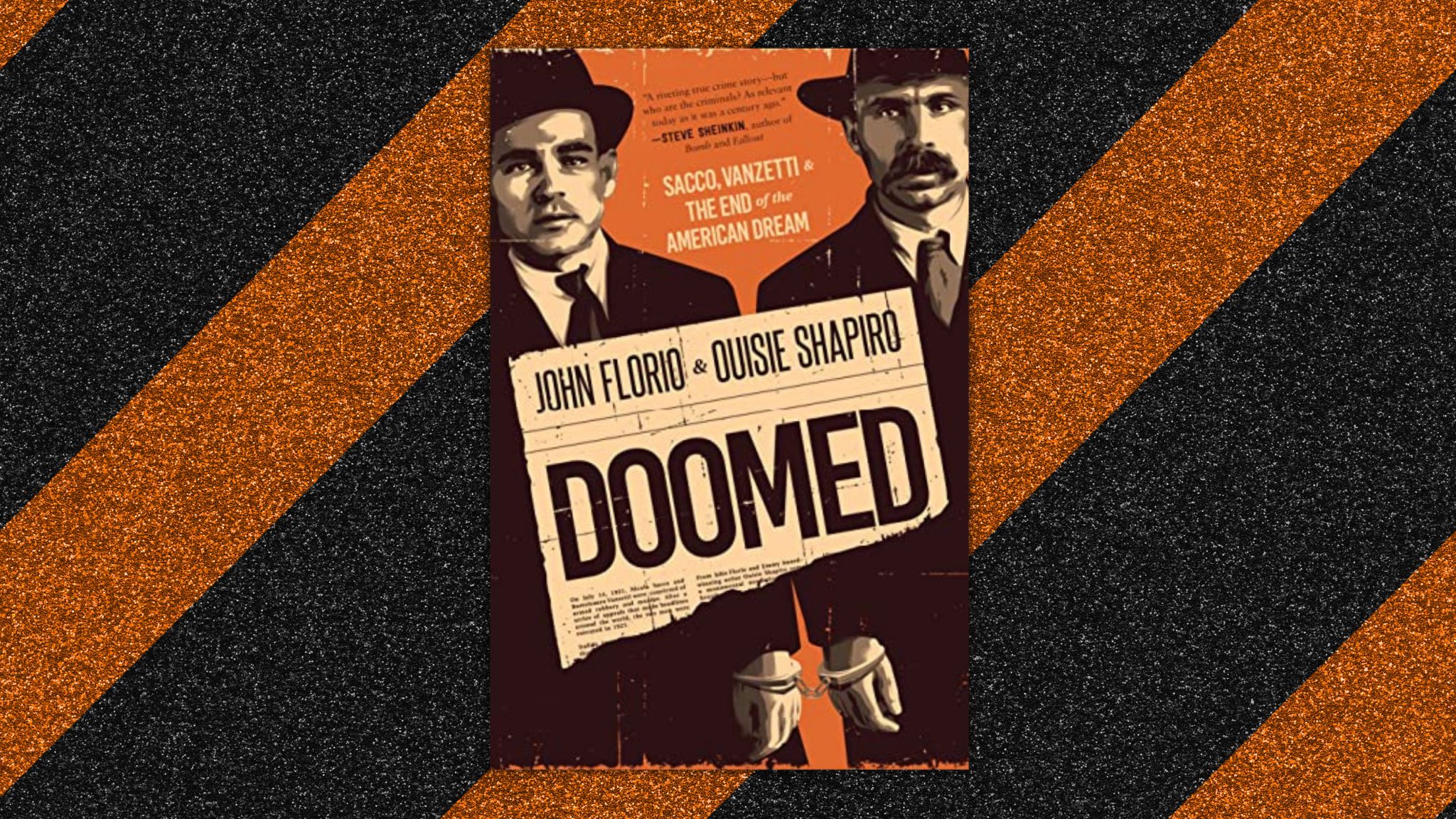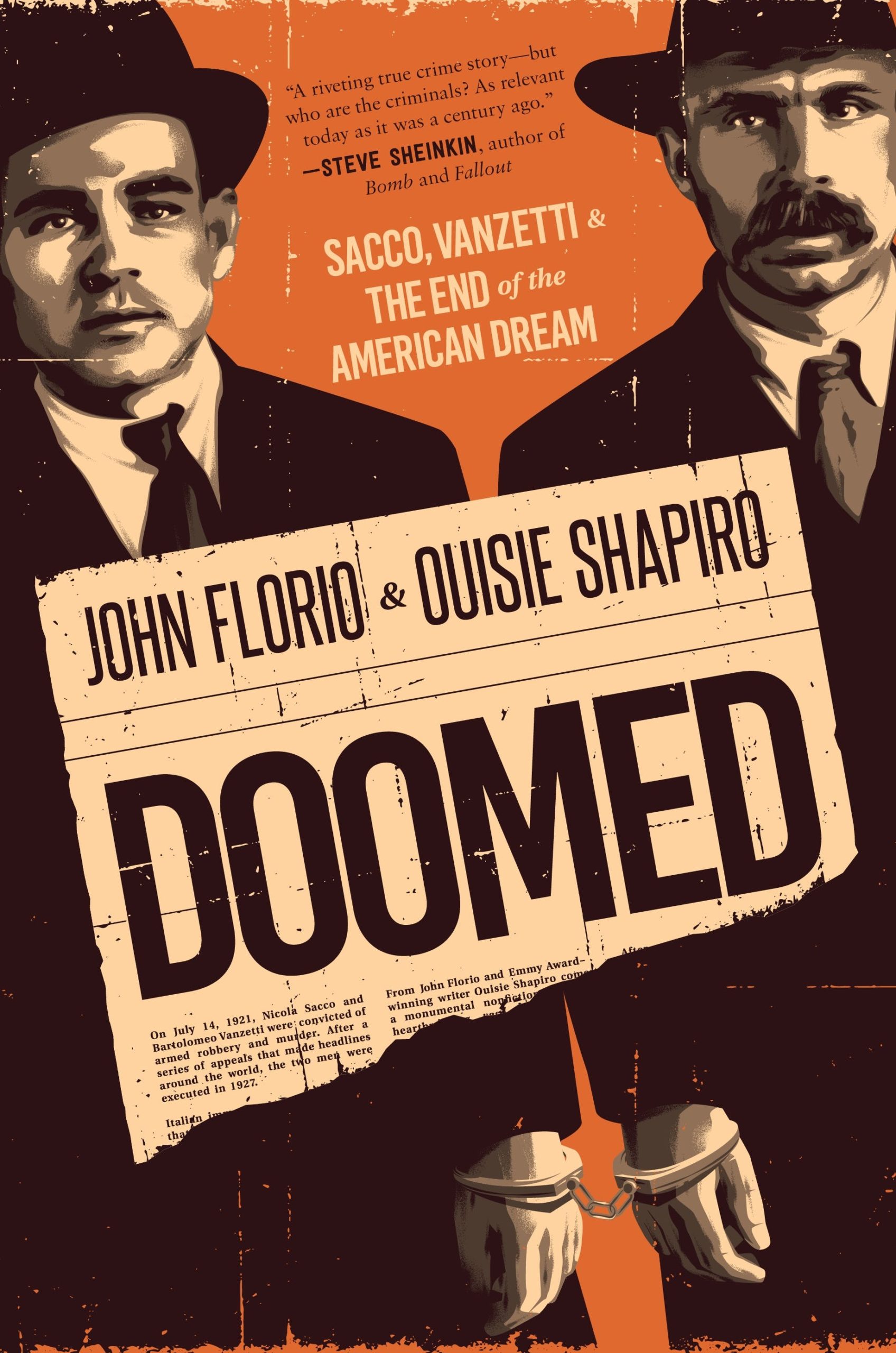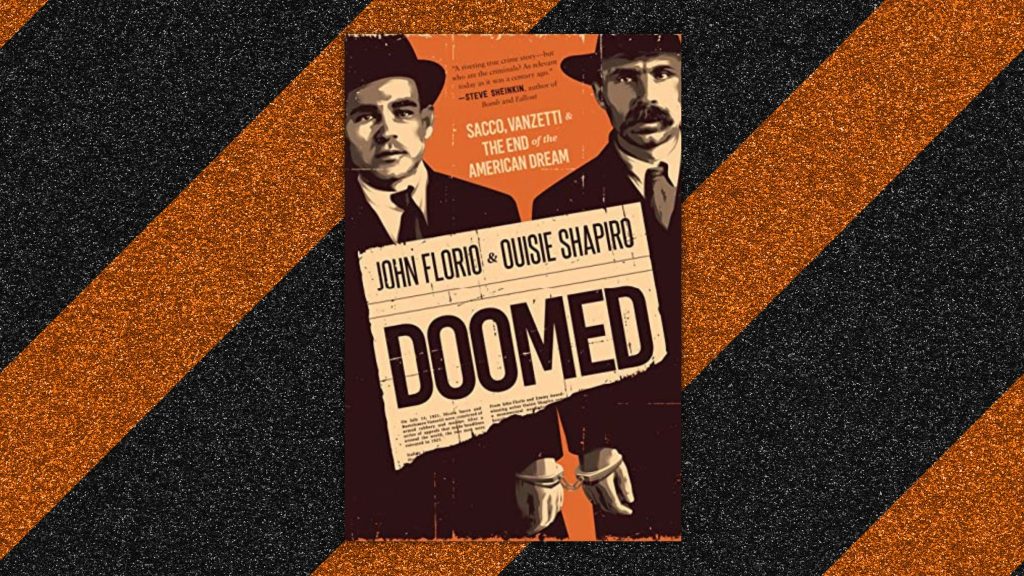
Doomed: Sacco, Vanzetti & the End of the American Dream by John Florio
What’s it About?
The tale of two Italian immigrants and how they became symbols for an inequitable, unjust legal system in the United States.
“Remember! Justice Crucified August 23, 1927” was printed with black ink onto blood red felt armbands. These were handed out and worn by many of the over 7,000 mourners marching in the funeral cortege following the hearses bearing the bodies of Nicola Sacco and Bartolomeo Vanzetti.
The men, considered to be martyrs by many, were executed after a controversial trial, several failed appeals and seven years behind bars. As many as 200,000 people lined the streets of Boston to solemnly witness the procession. Protest marches were held in nearly every major city in America and globally in cities including Moscow, Tokyo, Rio, Buenos Aires, Sydney, Melbourne, and Dubai; on every continent except Antarctica.
The outrage and disbelief over denied justice triggered riots in some quarters! Who were these two Italian immigrants and how did they become symbols for an inequitable, unjust legal system in the United States?
Essential Historical Nonfiction for Young Adults
Doomed: Sacco and Vanzetti and the End of the American Dream (Roaring Brook Press) is a recently published, insightful work of YA nonfiction by Renaissance married couple John Florio and Ouisie Shapiro. It is, in my opinion, essential reading, suitable for middle and high school students from about 13 years old and up and belongs on the shelf of every school and public library in the country. This work of nonfiction is also eminently suitable for adults.
The writing is clear, concise and thoroughly researched. Each chapter of Doomed is illustrated with photographs and maps. The co-authors turned to source materials to relate the story as accurately as possible using new translations of Sacco and Vanzetti’s letters, plowing through volumes of trial transcripts, historical newspaper and magazine accounts and several case histories.
Dialogue within quotation marks is verbatim; exactly what was spoken. There are additional notes for each chapter and an extensive, detailed bibliography listed at the end of the book. John Florio and Ouisie Shapiro have succeeded admirably in a re-creation relating the history of this mind-numbing miscarriage of justice which continues to resonate.
Executed for Crimes They Did Not Commit
A combination of factors; criminal injustice, social inequity, fear, prejudice, and ignorance led to the heart-breaking true story of two marginalized men sent to the electric chair in 1927. Neither Sacco nor Vanzetti had any record of prior criminal offenses yet were executed for crimes they did not commit.
In the century since they were arrested, there have been untold countless instances of criminal injustices but only a few have attracted enduring global attention as the case of Sacco and Vanzetti. They were victims of a Red Scare that swept the United States following the Russian Revolution, caught up in a blaze of nationalism, xenophobia and anti-immigration fervor. “Close the borders and keep the foreigners out” is a simplistic, wrong-headed sentiment sadly not confined to any one decade.
The Lives of Sacco and Vanzetti
In 1920, Massachusetts was the American center for shoe manufacturing. Located in South Braintree, Slater and Morrill, one of the larger factories, was preparing for payday for their 400 employees. On April 15, Frederick Parmenter, the assistant paymaster, accompanied by Alessandro Berardelli, a company security guard, set out as usual on foot from the payroll office to the plant with two strong boxes containing nearly $15,800 in cash (over $230,000 in today’s dollars). A gunman, part of a gang of five, shot the men and fled with the strong boxes, escaping in a waiting Buick. A few shell casings from three different gun manufacturers and a cap commonly worn at the time were left at the scene.
The state police had little to go on and in a description of the gang cited, “probably foreigners except the light-haired chauffeur.” Later when arrested, Vanzetti was identified as the driver except he never learned to drive, had dark hair and a very distinctive and quite large drooping walrus mustache. The arresting officers, judge, prosecuting attorney and all white, all male native born jury did not let the facts get in the way of a swift conviction.
They would be tried in what amounted to a kangaroo court presided over by patrician Boston Brahmin Judge Webster Thayer who had in speeches already established his anti-immigrant, anti-anarchist views and could hardly be expected to conduct a fair and impartial trial. Readers will wish to discover for themselves what occurred to Sacco and Vanzetti during the next seven years and four months by reading Doomed.
Italian Immigrants and Anarchist Meetings
Nicola Sacco and Bartolomeo Vanzetti were immigrants from different villages who coincidentally left Italy in 1908 in pursuit of travel, adventure and the promise of a bright future in America. Sacco was just 17 years old when he left his home town of Torremaggiore located in the southeast “heel” of the boot of Italy. Vanzetti was born in Villaffalletto, in the northeast of the country, not far from Turin. He was three years older than Sacco, the son of a moderately successful farmer.
Vanzetti had been a baker in Italy but when he settled in Plymouth, Massachusetts, he acquired a cart and became a fish peddler, preferring to work outdoors as his own boss rather than toiling in a mill or factory. Sacco settled in Stoughton, Massachusetts where he found work in a shoe factory. He trained hard and became a skilled worker earning an excellent wage of $80 per week (equivalent in buying power to about $1200 now). It was sufficient for him to marry his girlfriend Rosina and start a family.
Disillusioned by the sweatshops and prevalent prejudice and mistreatment shown to immigrants, both men became involved in radical politics and met while attending anarchist meetings. They were associated with Italian anarchist Luigi Galleani who was on the government’s list of subversives and dangerous enemies. Many radicals were opposed to WWI.
When the United States entered the war in 1917, Galleani’s advice was to flee to Mexico to avoid conscription into the Army. They had little success advocating for anarchism there and returned home when the war ended nine or ten months later. Their history of being “draft dodgers” would work against them during their trial.
Sacco and Vanzetti were dark-complected immigrants with far-left political beliefs both of which spawned fear, mistrust and hatred. These hard-working men were fully literate in their native Italian and had quickly learned to communicate but spoke accented, broken English and were unable to fully understand complex legalese.
Shortly before his execution, Vanzetti wrote, “I never committed a crime in my life … I am suffering because I am a radical and indeed I am a radical; I have suffered because I was an Italian, and indeed I am an Italian; I have suffered more for my family and for my beloved than for myself; but I am so convinced to be right that you can only kill me once but if you could execute me two times, and if I could be reborn two other times, I would live again to do what I have done already.”
Artists, Poets and Songwriters Call for Retrial
The trial of Sacco and Vanzetti and the subsequent futile appeals became a worldwide cause célèbre with numerous luminaries actively campaigning for a retrial. Among the outspoken were Albert Einstein, Harvard law professor and future Supreme Court Justice Felix Frankfurter, Jane Addams, John Dos Passos, Upton Sinclair, Dorothy Parker, Ben Shahn, George Bernard Shaw, and H. G. Wells. The New York Times published the poem Justice Denied in Massachusetts by celebrated poet Edna St. Vincent Millay the day before Sacco and Vanzetti were electrocuted.
Their names became a symbol for miscarriage of justice and the case continues to be studied in law schools. Several songs were written about them and their trial including Woody Guthrie’s ballad Two Good Men, later sung by Pete Seeger and Joan Baez. The story was made into a 1971 movie in Italy. There have been numerous books, articles, poems, documentaries and plays.
Anton Coppola, uncle of film director Frances Ford Coppola, wrote an opera about the Sacco and Vanzetti case that premiered in 2001 at Opera Tampa. Massachusetts governor Michael Dukakis, a life-long opponent of capital punishment, proclaimed “Nicola Sacco and Bartolomeo Vanzetti Memorial Day” on August 23, 1977, the 50th anniversary of Sacco and Vanzetti’s execution. He declared “that any stigma and disgrace should be forever removed from the names of Nicola Sacco and Bartolomeo Vanzetti,” and presented a copy of the proclamation to Spencer Sacco, grandson of Nicola, who was present for the ceremony.
Qualified Authors with Fascinating Subject-Matter
Doomed: Sacco & Vanzetti & The End of the American Dream is an important work that I highly recommend by two fine writers, John Florio and Ouisie Shapiro. Together and separately they write fiction and nonfiction books for adults as well as children’s and young adult books, magazine and newspaper articles. Ouisie Shapiro, who earned a Master’s Degree in Journalism from NYU, is renowned for her excellent work on sports documentaries and has won an astounding six Emmy Awards for screenwriting. She is also a noteworthy professional gardener and garden designer. John Florio teaches in a MFA creative writing program, creates and leads writing workshops and is a classical pianist.
Their writing about the underdogs, the outcasts and dreamers striving to achieve greatness is eloquent, spare, poetic and sometimes gritty. I abhor the sport of boxing but was glued to my chair when I read One Punch from the Promised Land about brothers Leon and Michael Spinks and again when I read their YA book War in the Ring about the Joe Louis and Max Schmeling fights. Their next collaboration is another YA book about retired NYPD detective Frank Serpico, whistleblower on police corruption. I can hardly wait.
An Interview with John Florio and Ouisie Shapiro
Interviewer: Linda Hitchcock
LKH: What inspired you to seek out source material and write about Sacco & Vanzetti now in advance of the 2027 centenary of their execution?
JF/OS: We’re always on the lookout for important stories that still need to be told. When we saw that the Sacco & Vanzetti case was not covered in the young adult market, we felt that hole needed to be filled. So, we did our best to fill it.
LKH: Do either of you have 19th or 20th century immigrant ancestors? If so, did they face hardships, discrimination and disappointments in pursuing their American Dream?
JF/OS: Yes. John’s grandparents came from Italy to America during the same migration as Sacco and Vanzetti. They also faced hardships and discrimination. John’s grandfather’s naturalization papers list his country of origin as “Italy,” his color as “white,” and his complexion as “dark.” The intent of that last piece of information is obvious.
LKH: What is the target age range for this YA book?
JF/OS: We see the sweet spot as 8th grade and up.
LKH: Are underdogs or antiheroes a subject preference? Several of your books and articles seem to feature people who are lesser known or who almost but not quite achieved their dreams.
JF/OS: Seems that way, doesn’t it? We’re drawn to the outsiders, the ostracized. We gravitate to stories that deal with civil rights, politics, injustice. In the case of Sacco and Vanzetti, we explored a single crime against two Italian immigrants, but the story of racism can be found in cities and towns throughout America
LKH: Baseball, boxing, figure skating, football- how did sports and sports writing become a passion and develop into your accomplished careers?
JF/OS: We’re both sports fans, especially baseball. (Ouisie roots for the Red Sox; John is a diehard Yankees fan.) But in many cases, our stories aren’t strictly about the sport, but, rather, about the off-the-field stories that take place in that arena. We’re back to the outsiders again, back to civil rights, politics, and injustice.
LKH: How do you determine joint writing projects and how does the actual process work for you? Does one of you do more research and the other more writing? Do you alternate chapters? Also if you want to include any personal information such as where you met, please feel free.
JF/OS: We thought you were going to ask how married couples can co-author books and remain civil to each other! The short answer is that we start out by agreeing on the best way to tell the story. After that, everything seems to fall into place, because we are both committed to that vision. As for specific roles, we both lean on our strong points: Ouisie typically handles the research and John provides a voice to the narrative. But it’s not always that clean. At times, especially on deadline, we’ve sat opposite each other with our laptops open, firing lines at each other, using what works, ignoring what doesn’t. When that happens, we’re not even aware of who is writing which line. We’re just giving the story whatever it needs.
As for our personal lives: We’d tell you how we met but you already know— assuming you’ve seen “When Harry Met Sally.”
LKH: Will there be more Jersey Leo novels?
JF/OS: Maybe down the road. Right now, John is working on a novel with a different protagonist. The story takes place in the 1950s. At that point, Jersey would be in his mid-40s. Hmm, perhaps he can make an appearance tending bar at a watering hole in Brooklyn.
LKH: What are your favorite banned books?
JF/OS: Maus by Art Spiegelman is a work of staggering genius.
In the YA world, Last Night at the Telegraph Club by Melinda Lo is a terrific book.
Looks like we’re picking outsiders again.
LKH: Who were your favorite authors growing up? What authors and/or books influenced you? Whose work are you reading now?
JF/OS: John: I always spent a lot of time in the library. I grew up on the Hardy Boys, Marvel comics, Sports Illustrated—the fun stuff. But in the seventh grade, Miss Valvano assigned To Kill a Mockingbird to our class. Wow, what a powerful book. It was then that I realized writing could be serious literature. Nowadays, I’m rediscovering some of the hardboiled writers: Ellroy, Hammett, Chandler, Cain.
Ouisie: I also fell in love with To Kill a Mockingbird, as well as Charlotte’s Web. Neither book bore any relation to my suburban Boston surroundings, but the characters—and the storytelling—blew me away.
LKH: When did you know you were a writer?
JS/OS: John: I always loved the narrative form—in books, movies, music. I still love when the forms cross over and create new genres, new ways of telling stories. As for my writing career, I started in commercial writing (and music composition, if that counts). So, I suppose I’ve always been a writer. But I didn’t start creative writing until about 20 years ago.
Ouisie: I wrote an essay on Helen Keller and read it to my mother. I remember nothing about it, except that when I finished, my mother told me I was a writer.
LKH: What lessons have your books taught you?
JF/OS: The story is bigger, and more important, than the person(s) who writes it.
LKH: How do you balance your dual careers? How do you balance writing, teaching and workshop commitments with lectures and author talks, especially with John’s role at the Stonecoast MFA program requiring he teach at writing residencies in Maine?
JF/OS: To us, writing is a full-time job. Sure, we’re freelancers. But we put in eight-hour days, treating various projects as, say, different clients. When we’re not on an assignment, we’re strategizing new ideas. It’s what we love, but it’s also a business, our way of paying the bills.
LKH: What do you like to do when you are not writing or doing research for a new book project?
JF/OS: John is a classical pianist and he studies Ying Jow Pai kung fu. Ouisie studies Italian and is a professional gardener. She’s currently designing an edible garden on Staten Island for people with disabilities.
LKH: What would you like people who have not yet read your work to know about your writing?
JF/OS: It’s worth reading. We hope.

Publish Date: 1/24/2023
Author: John Florio
Page Count: 208 pages
Publisher: Roaring Brook Press
ISBN: 9781250621931

